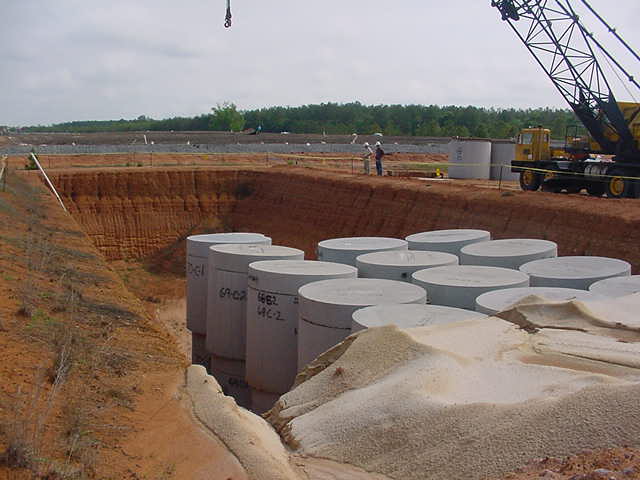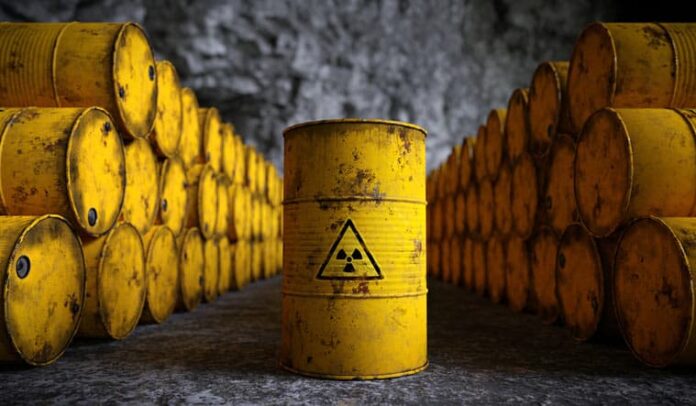Radioactive waste is a type of waste that contains radioactive material that can be a result of many different activities. Without proper management, it can pose a huge risk to not only the environment but also human health. What if things go wrong one day and the radioactive waste is released into the atmosphere? These are what you are going to read about today, so let’s find out.
1What Is Radioactive Waste?

Radioactive waste or nuclear waste is a byproduct from fuel processing plants, hospitals, nuclear reactors, and research facilities. There are 3 common types of radioactive waste including High-Level Waste, Intermediate-Level Waste, and Low-Level Waste. High-level waste is primarily spent uranium fuel removed from nuclear power reactors after producing electricity or no longer efficient. The fuel is made up of metal duel rods that contain small ceramic pellets of enriched uranium oxide. It is solid when it goes into the reactor, and it is solid when it comes out. Used nuclear fuel is recyclable to be byproducts and new fuel. High-level wastes are hazardous because they produce fatal radiation doses during short periods of direct exposure to humans.
As for intermediate-level and low-level wastes, they come from reactor operations and other uses of radioactive materials in industrial and medical. This type focuses on more items that have become contaminated with radioactive material or through exposure to neutron radiation. The most common objects include filters, equipment and tools, injection needles, medical tubes, protective clothing and shoe covers, syringes, etc. Even laboratory animal carcasses and tissues, swabs, and wiping rags can also be among the wastes. Intermediate-level and low-level wastes are typically stored on-site by licenses until they have decayed away. They also stay until the amounts are large enough for shipment to a low-level waste disposal site.
2Radioactive Storage

Many countries are currently using interim surface or sub-surface storage waste facilities to ensure the safe storage of hazardous radioactive waste. This type of storage is generally for high-level and intermediate-level wastes, including used nuclear fuel from reactors. Another storage method is “storage ponds” that are between 7 to 12 meters deep. This is to allow several meters of water to cover the racked fuel assemblies that are about 4 meters long. There are multiple metal racks with neutron absorbers incorporated in them. The circulating water will both cool and shield the fuel, holding it for the life of the reactor. The pools are robust due to their construction from thick reinforced concrete with steel liners. The storage of used fuel is normally under water for at least 5 years before going into dry storage.
After 5 years of storage, the fuel assemblies will be in dry casks or vaults. The transfer from wet storage to dry casks at a power plant site may use special shielded transfer casks. They are less robust, and they contain a sealed canister that is easy to transfer from one kind of cask to another. There is another type of container which is multipurpose canister that can hold up to 89 fuel assemblies with inert gas. It is common for transporting, storing, and eventually disposal of used fuel. For storage, each multipurpose canister is enclosed in a concrete and steel ventilated storage module or overpack. They commonly stand about 6 meters high on the surface, keeping cool by air convection. The modules are robust, and they provide full shielding for the canisters.
3Why Is Radioactive Waste Dangerous?

It is obvious that inhaling, ingestion, or touching radioactive waste can be very dangerous for the human body. According to Conserve Energy Future, nuclear waste disposal can cause several impacts on both humans and nature. The most common causes that lead to those consequences including:
Accidents
As you probably already know, accidents did happen several times due to the improper disposal of radioactive materials. It resulted in a number of disastrous situations that led to the contamination of ponds, rivers, and even the sea. Such accidents harm and threaten the life of animals that reside not only in but also around the areas. The effects are the same for people who rely on the water sources from those regions to survive.
Health Effects
What could be the health effects resulting from exposure to radioactive waste? The main problem with radioactive waste is the long-term health effects that can last for years depending on the exposure. Consuming food growing on land affected by waste, drinking contaminated water, or inhaling contaminated air can harm human health. It can also affect the appearance, health, and well-being of newborn babies resulting from the mother’s exposure to the waste. Exposure to large amounts of radioactivity can also cause central nervous system damage, diarrhea, hair loss, hemorrhage, nausea, and death. Similar to nuclear reactions, radioactive waste may also cause cancer and other DNA problems in the area. This case is more common in fetuses and young children which affects their growth greatly.
Scavenging
This problem often occurs in developing countries where people risk their lives to scavenge for abandoned nuclear waste. They look for waste that is still radioactive because there is a market for these goods in some countries. Although not abundant, there is never a zero chance of unprofessional radioactive disposal in some areas. The people will take the opportunity and expose themselves to dangerous levels of radiation to make money to survive. Even if it is not as dangerous as nuclear reactions, the waste can still pose dangerous effects on humans. Those who are exposed to nuclear waste can also expose to other people that don’t even go scavenging. The scavengers often end up in the hospital before eventually dying of health problems due to exposure to radioactive materials.
4How Is It Disposed Of?

The disposal of low-level waste is straightforward, and the process can be done safely almost anywhere. Most low-level radioactive waste is typically sent to land-based disposal immediately, following its packaging for long-term management. Things are different with high-level waste because the first step is storage to allow the decay of its heat and radioactivity. This is to ensure that it is safer to handle, and the storage may be in dry casks or in ponds.
The most favorable and probably safest solution is deep geological disposal at depths between 250 and 1000 meters for mined repositories. There is also another solution which is near-surface disposal which is at ground level or in caverns below ground level. Another disposal method is Direct Disposal, a management strategy where used nuclear fuel is designated as waste. This type of disposal goes to canisters for an underground repository without any recycling. The canisters will be sealed in tunnels with rocks and clay along with the waste from recycling or so-called fission products.
Bottom Line
Radioactive wastes will naturally decay over time, and it is no longer hazardous after sufficient decaying. The problem is that radioactive materials can take from a few hours to hundreds of thousands of years. Let’s just hope that the development and improvement of technology can prevent those problems from happening as much as possible. We already damage many things on Earth, and releasing radioactive materials into the environment should not be one of those.
Related Post: Biggest Nucler Accidents In History




